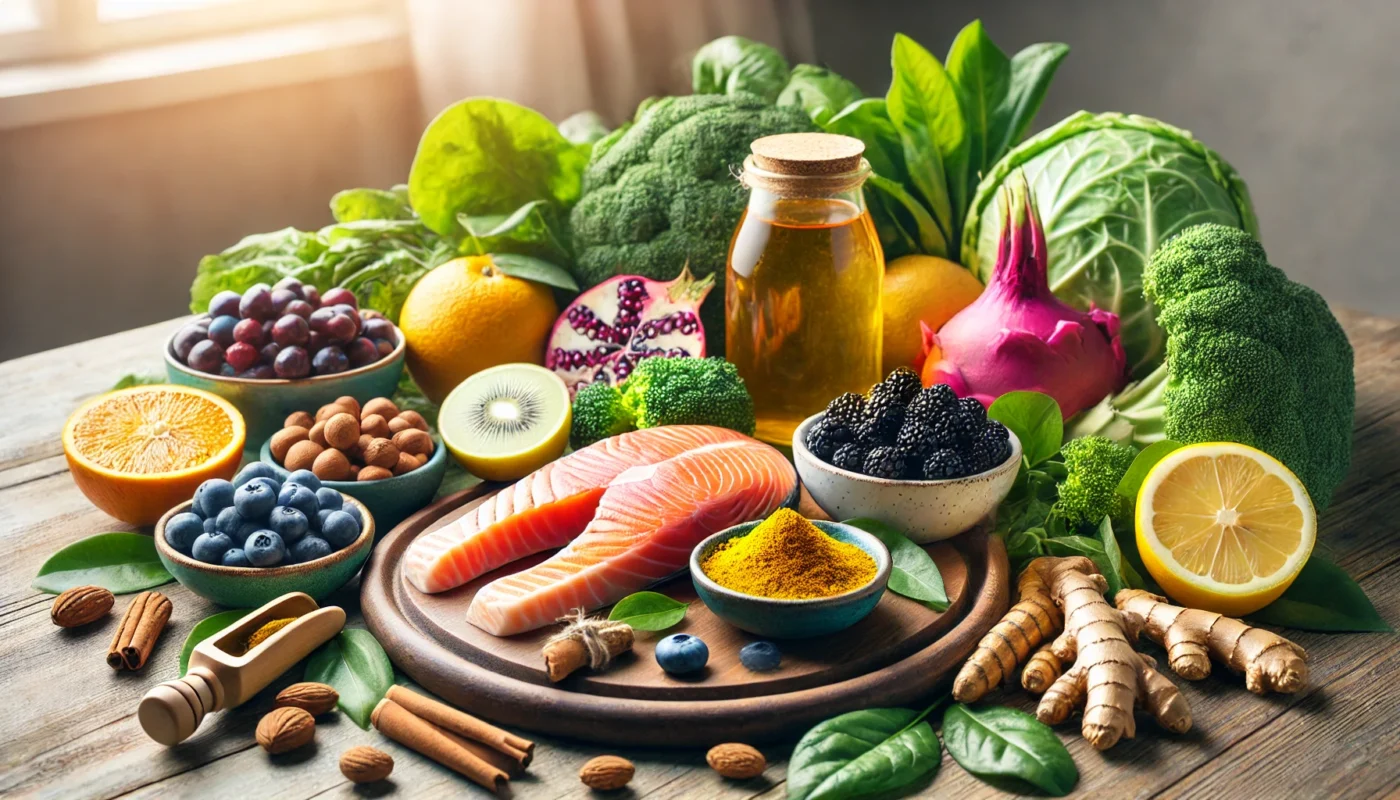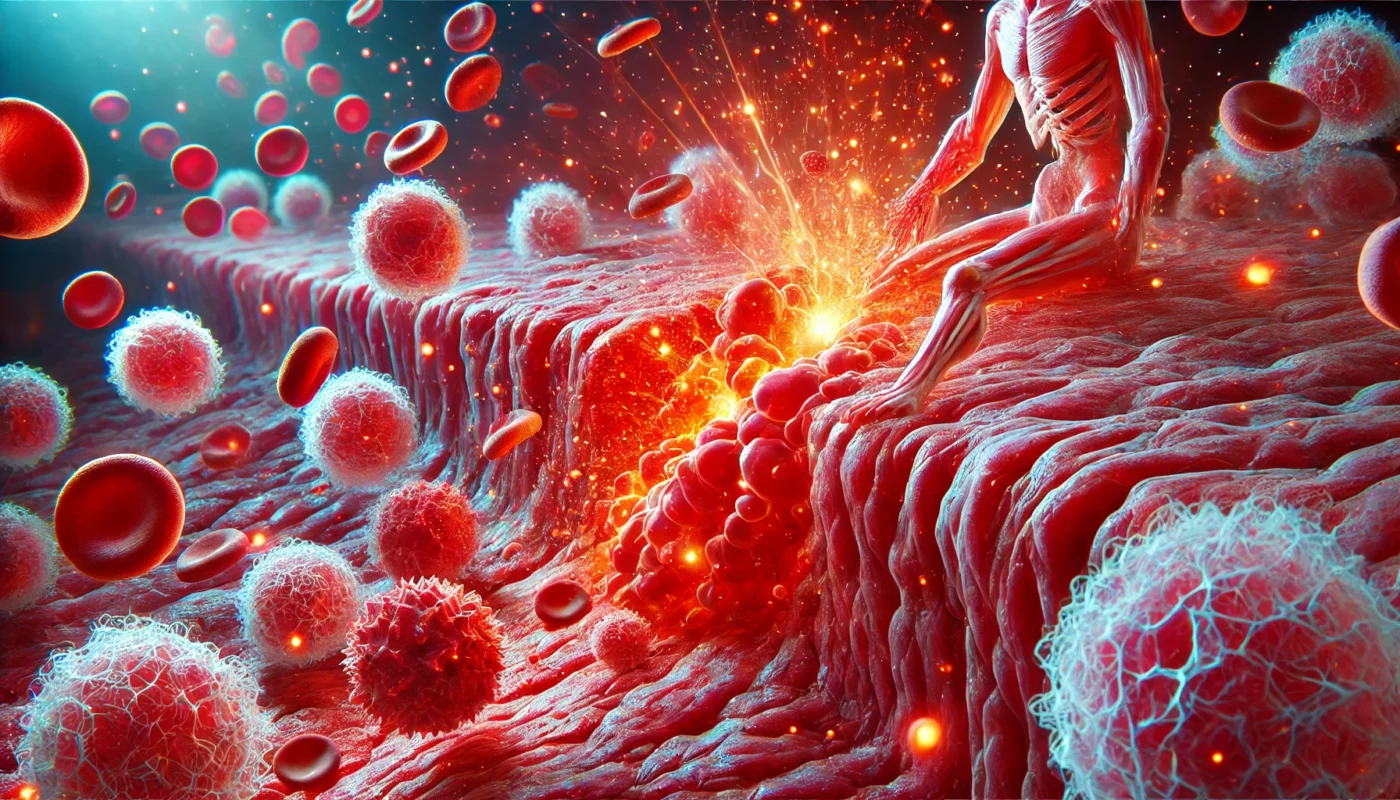Inflammation is the body’s natural response to injury or infection. It serves as a protective mechanism, mobilizing the immune system to heal damaged tissue and ward off harmful pathogens. There are two types of inflammation: acute and chronic.
Understanding the Mechanism
The inflammation process is initiated when the immune system detects a harmful stimulus, such as a pathogen or injury. Upon detection, immune cells release signaling molecules called cytokines and chemokines, which attract more immune cells to the affected area. This influx of cells leads to the classic signs of inflammation: redness, heat, swelling, and pain. These signs are indicative of increased blood flow, capillary dilation, and immune activity, all of which are necessary for the healing process.
Acute Inflammation
Acute inflammation is the body’s immediate response to harmful stimuli. It is characterized by redness, swelling, heat, and pain, which are signs of increased blood flow and immune activity in the affected area. This type of inflammation is typically short-lived and subsides once the healing process is underway.
Characteristics and Duration
Acute inflammation generally lasts for a few days, depending on the severity of the injury or infection. It involves the rapid onset of symptoms that are crucial for initiating tissue repair. The body utilizes this time to deliver essential immune cells, nutrients, and oxygen to the site, ensuring that repair mechanisms are activated promptly.
Protective Role
The protective role of acute inflammation cannot be overstated. By localizing the infection or injury, it prevents the spread of pathogens and limits tissue damage. Furthermore, it facilitates the removal of dead cells and debris, allowing for clearer pathways for new tissue growth.
Signals for Repair
Inflammation not only clears the way for repair but also sends signals to other body systems to start the regeneration process. Growth factors released during inflammation encourage the formation of new blood vessels and tissue regeneration, crucial for efficient healing.
Chronic Inflammation
Chronic inflammation, on the other hand, occurs when the inflammatory response persists beyond its usefulness. This prolonged inflammation can lead to tissue damage and is associated with various chronic diseases, such as arthritis, heart disease, and diabetes.
Causes and Triggers
Chronic inflammation can be triggered by persistent infections, prolonged exposure to irritants, or autoimmune responses where the body mistakenly attacks its own tissues. Lifestyle factors, such as stress, poor diet, and lack of exercise, can also contribute to its development.
Health Implications
The health implications of chronic inflammation are far-reaching. Over time, it can lead to the breakdown of healthy cells and tissues, resulting in conditions like inflammatory bowel disease, rheumatoid arthritis, and even certain cancers. Understanding these implications highlights the importance of managing inflammation effectively.
Monitoring and Management
Monitoring inflammation markers, such as C-reactive protein (CRP) and erythrocyte sedimentation rate (ESR), can help in assessing the level of inflammation in the body. Effective management involves lifestyle modifications, stress reduction, and, when necessary, medication under professional guidance.
You May Also Like: Understanding Autoimmune Fatigue: Causes and Solutions

Is Inflammation Good for Healing?
The Benefits of Inflammation in Healing
The question “is inflammation good for healing?” often arises, especially among those seeking to optimize their health. The answer is yes—when it is acute and appropriately regulated. Here’s why:
Increased Blood Flow
Inflammation increases blood flow to the injured area, delivering oxygen and essential nutrients that facilitate tissue repair. This increased circulation is vital for supplying the necessary components for healing and for removing metabolic waste products that accumulate during the repair process.
Immune System Activation
Inflammation activates the immune system, helping to eliminate pathogens and prevent infection. The immune cells that are recruited to the site of injury or infection play a critical role in neutralizing harmful agents and ensuring that they do not spread to other parts of the body.
Removal of Debris
Inflammatory cells clear out damaged cells and debris, making way for new tissue growth. This cleanup process is essential for creating an optimal environment for regeneration, allowing new cells to proliferate without obstruction.
Signal for Repair
It signals the body to begin the repair process, recruiting cells that rebuild and strengthen the affected tissue. Growth factors and cytokines released during inflammation are key players in this signaling, guiding the repair and regeneration processes efficiently.
Does Inflammation Help Healing?
In simple terms, inflammation is an indispensable part of the healing process. It serves as the body’s call to action, initiating repair and recovery. However, the key lies in managing and resolving inflammation effectively to prevent it from becoming chronic.
Balancing the Response
Balancing the inflammatory response is crucial to ensuring that it aids rather than hinders healing. This involves regulating the intensity and duration of inflammation, avoiding excessive or prolonged responses that can lead to tissue damage.
Role of Anti-inflammatory Agents
Anti-inflammatory agents, both natural and pharmaceutical, can play a role in modulating the inflammatory response. These agents can help reduce excessive inflammation, ensuring that it remains within the optimal range for healing.
Personalized Approaches
Recognizing that each individual’s inflammatory response is unique, personalized approaches to managing inflammation are essential. This includes tailoring dietary, exercise, and lifestyle recommendations to suit specific needs and conditions.
Managing Inflammation for Optimal Healing
While inflammation is beneficial, it’s crucial to ensure that it doesn’t linger longer than necessary. Here are some strategies to manage inflammation effectively:
Diet and Nutrition
Anti-inflammatory Foods
Incorporate foods rich in omega-3 fatty acids (such as salmon and flaxseed), antioxidants (such as berries and leafy greens), and polyphenols (such as olive oil and turmeric) to help reduce inflammation. These foods contain compounds that can help modulate the inflammatory response, promoting healing and reducing the risk of chronic inflammation.
Limit Pro-inflammatory Foods
Reduce intake of processed foods, refined sugars, and trans fats, which can exacerbate inflammation. These foods can trigger inflammatory pathways and should be minimized to support optimal health and healing.
Hydration and Gut Health
Maintaining adequate hydration is also essential, as it supports cellular functions and the removal of toxins. Additionally, promoting gut health through the consumption of fiber-rich foods and probiotics can positively influence inflammation levels.
Physical Activity
Regular Exercise
Engaging in regular physical activity can help modulate the inflammatory response. However, it’s important to avoid overtraining, which can lead to increased inflammation. Finding a balance between activity and rest is key to promoting healing and reducing inflammation.
Types of Exercise
Incorporate a variety of exercises, including aerobic, strength, and flexibility activities, to ensure a well-rounded approach that supports the body’s systems. Each type of exercise offers unique benefits that collectively contribute to managing inflammation.
Recovery and Rest
Prioritize recovery and rest days to allow the body to repair and adapt. Proper recovery helps prevent overuse injuries and chronic inflammation, promoting long-term health and wellness.
Stress Management
Mindfulness and Relaxation Techniques
Practices such as yoga, meditation, and deep breathing can help reduce stress and lower inflammation levels. These techniques promote relaxation and can positively impact the body’s inflammatory markers, supporting overall health.
Cognitive Behavioral Strategies
Cognitive-behavioral strategies can also be beneficial in managing stress and its impact on inflammation. By addressing thought patterns and behaviors, individuals can develop healthier responses to stressors, reducing their inflammatory effects.
Social Support and Connection
Maintaining strong social connections and seeking support from friends and family can also help in managing stress. Social interactions provide emotional support and can enhance resilience against stress-related inflammation.
Adequate Sleep
Restorative Sleep
Prioritize quality sleep, as insufficient rest can increase inflammatory markers in the body. Sleep is a crucial time for the body to repair and regenerate, and ensuring adequate sleep can significantly impact inflammation levels.
Sleep Hygiene Practices
Implementing sleep hygiene practices, such as maintaining a regular sleep schedule, creating a comfortable sleep environment, and limiting screen time before bed, can enhance sleep quality and support inflammation management.
Addressing Sleep Disorders
If sleep disorders are present, seeking professional help can ensure that these issues are effectively addressed, reducing their impact on inflammation and overall health.

Holistic Approaches to Supporting the Healing Process
Holistic and alternative approaches can complement traditional methods of managing inflammation. Here are some practices to consider:
Herbal Supplements
Turmeric and Ginger
Known for their anti-inflammatory properties, these herbs can be taken as supplements or incorporated into your diet. They contain active compounds, such as curcumin and gingerol, that have been shown to modulate inflammatory pathways and support healing.
Boswellia and Arnica
These are popular choices for reducing inflammation and pain. Boswellia has been used traditionally for its anti-inflammatory effects, while arnica is often applied topically to alleviate muscle and joint discomfort.
Echinacea and Green Tea
Echinacea and green tea are also noted for their anti-inflammatory benefits. Echinacea can support immune function, while green tea’s polyphenols offer potent antioxidant and anti-inflammatory effects.
Acupuncture
Modulating Inflammatory Response
Acupuncture, an ancient practice, may help modulate the inflammatory response and promote healing. By stimulating specific points on the body, acupuncture can enhance circulation and reduce stress, contributing to inflammation management.
Pain Relief and Relaxation
This practice is also known for its pain-relieving and relaxing effects, which can be particularly beneficial in managing inflammation-related discomfort. By promoting relaxation, acupuncture can complement other anti-inflammatory strategies.
Integrative Care
Incorporating acupuncture into an integrative care plan can enhance its effectiveness, combining traditional and modern approaches to optimize healing and inflammation management.
Massage Therapy
Circulation Improvement
Massage therapy can improve circulation, reduce muscle tension, and assist in the removal of metabolic waste products from the tissues. This enhanced circulation can support the body’s natural healing processes and reduce inflammation.
Stress Reduction
The relaxation benefits of massage therapy can also help lower stress levels, indirectly influencing inflammation. By promoting relaxation and reducing stress, massage therapy contributes to a holistic approach to inflammation management.
Tailored Techniques
Different massage techniques, such as deep tissue, Swedish, or lymphatic drainage, can be tailored to individual needs, providing targeted support for inflammation and healing.
Understanding When Inflammation Becomes Harmful
It’s important to recognize when inflammation becomes chronic, as it can contribute to various health issues. If you experience prolonged inflammation, consult a healthcare professional for an appropriate evaluation and management plan.
Recognizing Chronic Inflammation
Chronic inflammation can manifest as persistent pain, fatigue, and low-grade fever. It may also be associated with long-term conditions such as cardiovascular disease, metabolic syndrome, and autoimmune disorders.
Symptoms and Signs
Identifying symptoms and signs of chronic inflammation can be challenging, as they often overlap with other conditions. Persistent fatigue, joint pain, and unexplained weight changes are common indicators that warrant further investigation.
Diagnostic Tools
Healthcare professionals can use diagnostic tools, such as blood tests and imaging studies, to assess inflammation levels and identify underlying causes. These tools are essential for developing an effective management strategy.
Long-term Implications
Understanding the long-term implications of chronic inflammation is crucial for preventing its progression and associated health risks. Early intervention and management can significantly improve outcomes and quality of life.

Conclusion
Inflammation plays a pivotal role in the healing process, acting as the body’s first line of defense against injury and infection. By understanding and managing inflammation effectively, you can harness its benefits for optimal health and recovery. Remember, while inflammation is essential for healing, maintaining a balance is key to preventing it from becoming chronic and detrimental to your health. By incorporating anti-inflammatory foods, engaging in regular physical activity, managing stress, and exploring holistic approaches, you can support your body’s natural healing process and promote overall well-being.
Inflammation, when understood and managed properly, becomes a powerful ally in the journey toward health and recovery. With the right knowledge and strategies, you can ensure that inflammation serves its intended purpose without causing harm. Embrace a comprehensive approach that combines diet, lifestyle changes, and holistic practices to unlock the full potential of your body’s healing capabilities.
Further Reading:
Playing with the fire of inflammation
Inflammation and wound healing: The role of the macrophage
Understanding acute and chronic inflammation
Sleep Hygiene, Inflammation Management, Holistic Health, Herbal Supplements, Acupuncture, Massage Therapy, Chronic Inflammation, Anti-inflammatory Diet, Stress Reduction, Healing Process, Integrative Care, Turmeric, Ginger, Boswellia, Echinacea, Green Tea, Pain Relief, Wellness Strategies
Important Note: The information contained in this article is for general informational purposes only, and should not be construed as health or medical advice, nor is it intended to diagnose, prevent, treat, or cure any disease or health condition. Before embarking on any diet, fitness regimen, or program of nutritional supplementation, it is advisable to consult your healthcare professional in order to determine its safety and probable efficacy in terms of your individual state of health.
Regarding Nutritional Supplements Or Other Non-Prescription Health Products: If any nutritional supplements or other non-prescription health products are mentioned in the foregoing article, any claims or statements made about them have not been evaluated by the U.S. Food and Drug Administration, and such nutritional supplements or other health products are not intended to diagnose, treat, cure, or prevent any disease.

